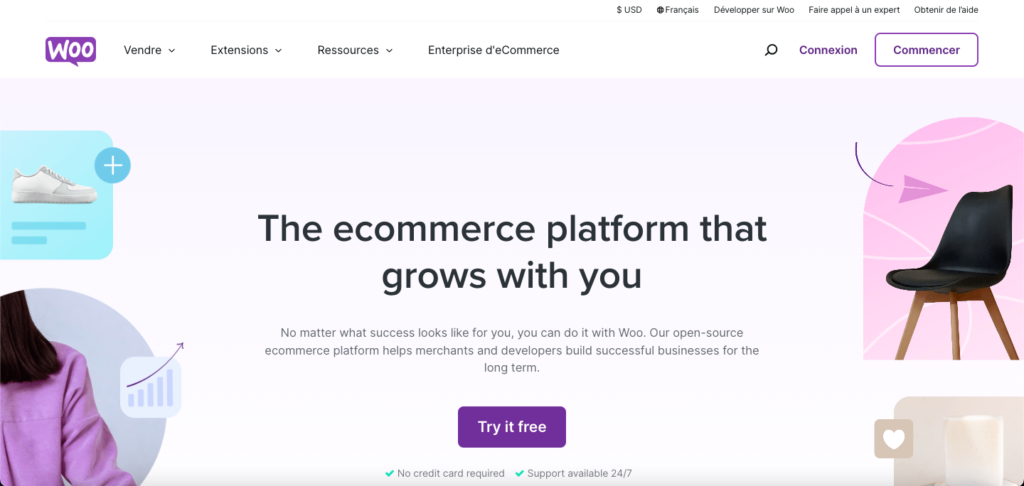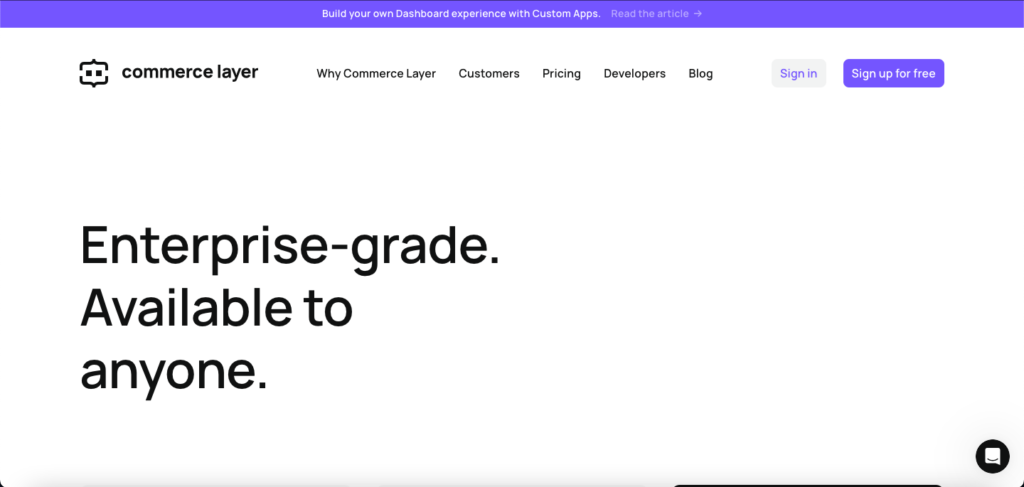
Selecting the right platform is crucial when building an e-commerce website. Making the wrong choice can jeopardize the success of your e-commerce business.
There are numerous e-commerce website builders available, and finding the one that best aligns with your business idea may appear to be a daunting task.
If you’re interested in learning more about the top e-commerce website builders, this article is tailored for you. We present eight of the best e-commerce website builders, outlining their user interface, key features, advantages, drawbacks, and pricing.
The 7 best e-Commerce site creators
1. Shopify
2. WooCommerce
3. BigCommerce
4. Wix
5. Squarespace
6. Magento
7. Volusion
Here are the top options available today, so you can make an informed decision and start selling online with confidence.
1. Shopify – Best for businesses that sell both online and offline
Shopify is undoubtedly one of the best e-commerce website builders in the market, boasting over a million online stores. Its popularity stems from its excellent marketing strategy and user-friendly selling features designed for beginners.
To get started with this e-commerce platform, users can choose from over 70 free and paid e-commerce templates on the official Shopify theme store and customize them as they see fit.
This e-commerce website builder comes equipped with a drag-and-drop builder, making it easy to add text and image sections to your website. Users can manage orders, customer accounts, inventory, shipping rates, discounts, gift cards, and payments all from a single dashboard.

Shopify also enables users to target abandoned shopping carts and facilitates offline sales through its point-of-sale software.
Users can also install third-party applications for features like live chat, dropshipping, and more. Many of these apps are available for free, while more advanced ones come with subscription-based pricing.
Shopify provides competitive shipping rates and access to its order fulfillment network, ensuring timely deliveries for an additional fee. It also offers detailed reports for tracking visitor statistics and business performance analysis.
Shopify offers 24/7 support via email, phone, and live chat for users with questions or issues. Additionally, it has a help center and a community forum.
Key Features:
Mobile App: Users on the go can access the Shopify dashboard and manage orders through the Shopify mobile app. Two other apps, Shopify POS for offline transactions and Shopify Inbox for customer chat, are also available.
Third-Party Apps: The Shopify App Store offers over 4,000 free and paid apps to enhance your online store. Examples include Printful, ShipStation, and Snapchat Ads.
Built-In SEO Tools: Shopify stores come with built-in SEO tools. Some aspects of SEO, such as canonical tags, sitemaps, and robots.txt files, are automatically added, while users can also edit title tags, meta descriptions, URLs, and image alt text.
Multichannel Sales: With this website builder, users can sell products through various channels, including in-person or offline, online marketplaces like Amazon and eBay, social media platforms like Instagram and Facebook, and buy buttons.
Marketing Automation: Shopify offers marketing tools for launching ad campaigns, including email marketing, Google Smart Shopping, and Facebook Ads.
Built-In Shipping Tool: Shopify’s native shipping suite, Shopify Shipping, partners with carriers like USPS, UPS, and DHL to offer reduced shipping rates. It also displays real-time shipping rates at checkout.
Native Payment Processor: This e-commerce website builder has its payment gateway, Shopify Payments, so there’s no need to connect third-party payment providers to your online store, although Shopify allows them.
Many Third-Party Payment Gateways: Shopify supports over 100 third-party payment gateways, including PayPal, Authorize.net, and Amazon Pay.
Multi-Currency Support: Shopify Payments supports multiple currencies worldwide, including the Euro, Hong Kong Dollar, and US Dollar.
Multilingual Support: Translate your store into different languages to expand your e-commerce globally. All users can sell in up to five languages, except enterprise-level merchants who can sell in up to 20 languages.
Pros:
Top-notch e-commerce themes designed for high conversion rates.
A wide selection of apps to extend your online store’s functionality, with carefully curated, bug-free options.
Cons:
Transaction fees in addition to the already high monthly fees.
Additional costs for premium themes (ranging from $150 to $350 one-time) and plugins ($5 to $20 per month) on top of Shopify’s service fees.
Domain registration is not included; users must purchase a custom domain separately.
The native payment gateway and shipping suite may not be available everywhere. Currently, Shopify Payments is only available in select countries, and Shopify Shipping is available to merchants in the United States, Canada, and Australia.
Pricing:
Shopify offers three plans: Basic Shopify for $29 per month, Shopify for $79 per month, and Advanced Shopify for $299 per month.
The appeal of higher-tier plans lies in their more competitive transaction fees. For transactions not using Shopify Payments, Basic Shopify charges a 2% transaction fee, Shopify charges 1%, and Advanced Shopify charges 0.5%.
All plans come with free hosting, an SSL certificate, generous bandwidth and storage, email forwarding, and the ability to sell an unlimited number of products. However, users must register a custom domain on their own.
Note that you may spend a bit more than usual if you purchase a custom theme and add plugins to your e-commerce site.
Shopify does not offer a free plan for online commerce but provides a 14-day free trial.
Read also: Cash register software: The 10 best in 2025
2. WooCommerce – Best for WordPress Website Owners

WooCommerce is a free, open-source plugin that adds e-commerce functionality to WordPress websites. It’s considered one of the top e-commerce site builders available.
To get started with WooCommerce, you need to first create a website using WordPress. Then, you can find WooCommerce in the official plugin directory and install it. Once activated, you can begin uploading products and content to your platform.
Pro Tip: Don’t hesitate to check out our website creation tutorial to get your site up and running in no time.
New online store owners won’t be left wondering where to start, as WooCommerce provides a helpful guide consisting of six main steps to follow: Store Details, Add My Products, Set Up Payments, Configure Taxes, Set Up Marketing Tools, and Customize My Store.
You can create an e-commerce website and configure all the settings directly from the WordPress admin dashboard. You can manage orders and products, view the customer list, add coupons, access business analytics, set up marketing tools, and check the system status.
Furthermore, WooCommerce’s code is SEO-friendly. It also allows users to add text and meta titles to product descriptions for better search engine ranking. However, you may need to install plugins to maximize its SEO capabilities.
Thousands of themes from the WordPress theme gallery are compatible with WooCommerce, and you can find even more on third-party theme websites like Theme Forest.
Users can add additional features to their online store by downloading various WooCommerce plugins and extensions. The performance of your e-commerce site depends on how you configure WooCommerce.
Key Features:
Third-Party Extensions: Expand your e-commerce site’s capabilities by using hundreds of free and paid extensions available on the official WooCommerce marketplace, such as Jetpack, Google Analytics, Zapier, etc.
Mobile App: The WooCommerce mobile app for iOS and Android allows users to manage shops and process orders from anywhere.
Marketing Automation: Boost your marketing efforts by selling products on Google Shopping, showcasing your online store on Facebook, or sending newsletters with Mailchimp.
Multilingual Support: WooCommerce supports over 20 languages, including French, Danish, and Spanish.
Multi-Currency Support: Sell to international customers with the help of various extensions like WooCommerce Payments, allowing them to see prices and pay in their local currency.
Product Blocks: Use WooCommerce Blocks to easily display products from your online store on various pages and posts on your site. Filter products based on categories and adjust display options like the number of rows or columns.
Numerous Payment Methods: WooCommerce supports major credit cards, cash on delivery, checks, bank transfers, and more. There are over 100 compatible payment gateways like PayPal, Amazon Pay, and Apple Pay.
Specifically Designed for WordPress: As the plugin was designed to be used on WordPress, it will always be compatible with the latest version of this CMS.
Pros:
Free: WooCommerce does not charge additional transaction fees, making it one of the most cost-effective options for WordPress websites.
Flexibility: Users have complete control over the appearance of their e-commerce site.
Ownership: As an open-source platform, you own all aspects of your online store.
Cons:
No phone support, but WooCommerce offers 24/7 live chat managed by a ticketing system, email support, documentation, and a public support forum.
Steep learning curve: Getting used to the interface may take some time.
Pricing:
WooCommerce is essentially free. However, it is only available to WordPress users who must set up web hosting, a domain, and an SSL certificate themselves.
The basic WooCommerce plugin is powerful enough for small businesses. You can then download plugins and extensions to expand functionality as your online store grows. These plugins cost from a few dollars to a few hundred dollars per month.
That being said, you can use WooCommerce for free to create a website for small businesses. However, you will also need web hosting and a domain. With Hostinger, you can get e-commerce hosting or a WordPress Business plan for $4.99/month. This plan includes a free domain and SSL certificate.
You can also register a domain separately. For example, a .com domain extension would cost $9.99.
The approximate minimum cost of creating an e-commerce site with WooCommerce is around $14.
3. BigCommerce – Best for Large Online Businesses

If you’re in search of an e-commerce website builder with robust built-in online store features, look no further.
To start, users can select a web design template that suits their online store. BigCommerce templates are visually appealing and professional.
In addition to the 12 free themes available, the official BigCommerce theme store offers numerous paid themes in various categories, from pets and animals to toys and games.
The e-commerce website builder utilizes a visual drag-and-drop page builder, allowing users to customize the site’s widgets and theme style without coding. You can also add elements such as text, images, a hero banner, a carousel, and call-to-action buttons.
BigCommerce offers a feature-rich dashboard for configuring and customizing your online store. It allows you to manage product catalogs, automate sales tax, or use custom tax tables, set up shipping rates, provide coupons and discounts, and create customer segments with personalized pricing.
Furthermore, the BigCommerce Analytics dashboard provides insights into orders, marketing, and customer data. The website builder also enables users to develop and test site changes in a simulated environment.
Most essential features, such as discount coupons and customer reviews, are already included in the base version of BigCommerce. This makes it a powerful e-commerce website builder, although it can be a bit overwhelming for beginners.
Fortunately, BigCommerce offers 24/7 live support via phone, email, and live chat. Users can also access its knowledge base and community forum. For those looking for additional features, various BigCommerce plugins are available.
Key Features:
SEO Tools: Enhance SEO performance with various tools, including customizable URLs, built-in metadata, and robots.txt editing.
Third-Party Integrations: Enjoy hundreds of free or paid integrations on the official e-commerce app marketplace. Examples of apps include Mailchimp, ShipStation, Justuno, and ShipperHQ.
Mobile App: Manage your online stores from anywhere with the BigCommerce mobile app, available on iOS and Android.
Product Filtering: Improve the user experience and enable customers to easily browse products using attributes like color, size, price, and reviews.
Many Payment Gateways: BigCommerce supports over 60 payment solutions serving more than 200 countries, including Amazon Pay, Apple Pay, Stripe, and PayPal.
Multi-Currency Support: BigCommerce is designed to accept payments in over 100 currencies, making international transactions easier.
Multichannel Sales: Sell online on major marketplaces and social media platforms, such as eBay, Google Shopping, and Amazon.
Pros:
Built-in Features: BigCommerce offers more native selling features compared to other e-commerce platforms, reducing the need to download additional plugins or extensions in most cases.
No Hidden Fees: BigCommerce does not add extra transaction fees for sales.
Quality E-commerce Themes: This e-commerce website builder has some of the best online store themes in the market, combining conversion principles with modern design.
Cons:
Exclusion Tiers: If you start making more than a certain amount annually, you’ll need to upgrade to the next plan. The threshold is $50,000 in annual revenue for the Standard plan.
Learning Curve: Due to the extensive feature set of BigCommerce, it may take some time to become familiar with the interface.
Pricing:
BigCommerce offers the Standard, Plus, and Pro plans for $29.95/month, $79.95/month, and $299.95/month, respectively.
Each of these paid plans comes with a revenue cap. This cap is set at $50,000, $180,000, and $400,000 in annual revenue for the Standard, Plus, and Pro plans, respectively. If businesses exceed the annual revenue limit, they can opt for the Enterprise plan, which offers customized pricing.
All plans include free hosting, an SSL certificate, ample bandwidth and storage, unlimited accounts and products for staff, and a 15-day free trial. Please note that there is no free plan.
4. Wix – Best for Small and Medium Businesses

Wix is a versatile website builder that offers an excellent drag-and-drop editor to help you create an e-commerce website.
Users can choose from over 500 professionally designed templates that are SEO-friendly, and they have the freedom to customize their e-commerce site to match any brand. The website’s visuals can be enhanced with Wix’s advanced design features, such as animation, video backgrounds, and scrolling effects.
The Wix editor’s sidebar features various icons for managing menus and pages, selecting colors and fonts, choosing backgrounds, adding apps and multimedia content, creating a blog, and setting up an online store.
After customizing the site layout, you can access the admin dashboard to add products to your online store, connect a payment gateway, and define shipping rules and taxes. If you have a custom domain, you can then publish the site to start selling.
Wix also supports those who want to start dropshipping and print-on-demand businesses. For dropshipping, products can be purchased from thousands of selected suppliers on the Modalyst marketplace. The print-on-demand feature allows users to design and sell custom embroidered or printed products.
You can also sell subscription boxes with carefully curated products or items that customers can buy regularly.
For business reporting, Wix’s built-in Analytics dashboard allows users to create detailed business reports with statistics on sales, marketing efforts, customer base, and best-selling products.
It’s worth noting that Wix e-commerce frequently updates its list of features available for online stores, so you can stay up-to-date on site features.
Key Features
Logo Maker: Use Wix Logo Maker to design a business logo within minutes by answering detailed questions about your business. Customize the logo, download it, and use it on your site and merchandise.
Business Name Generator: Enter a few words to include in your business name, and Wix Business Name Generator will provide over 100 suggestions.
SEO Tools: Users can edit meta tags, URL slugs, structured data, robots.txt files, and canonical tags. Wix also provides practical tools such as instant Google indexing, bulk 301 redirects, and pattern-based meta tags for multiple pages.
Third-Party Integrations: Choose from over 200 web apps on Wix’s official app marketplace to add various features to your e-commerce site. Some examples of apps include Privy, Weglot Translate, Easyship, Printify, and Wordtune.
Mobile App: Manage your online stores from anywhere using the Wix Owner app, available on iOS or Android. You can perform various tasks such as adding new products, processing orders, sending invoices, and monitoring inventory, just like on the desktop dashboard.
Multi-Channel Selling: Sell online through popular marketplaces and social media platforms like eBay, Amazon, Instagram, and Facebook.
Marketing Automation: This website builder provides native marketing tools for business promotion, including email marketing, promotional videos, custom or pre-made social media posts, and abandoned cart recovery.
Native Payment Solution: Wix’s payment processor, Wix Payments, is free, easy to set up, and has its own 24/7 support service, so users don’t need to worry about managing a third-party payment solution, although Wix also supports them.
Many Third-Party Payment Gateways: It supports over 50 third-party payment gateways, including Stripe, Square, PayPal, Afterpay, and PayU.
Currency Converter: This feature allows customers to view products in their local currency. However, it’s available only to users of Business Unlimited and Business VIP plans.
Multilingual Support: The Wix Multilingual app can automatically translate every element of the e-commerce site into over 150 languages.
Pros
User-Friendly. Wix’s user interface is intuitive and easy to navigate.
No Revenue Cap. There is no annual revenue limit, unlike other providers that may require you to upgrade when you exceed a set amount.
Customer Support. In addition to its knowledge base and community forum, Wix’s support team can assist users via phone, live chat, and support tickets.
Cons
E-commerce Capabilities: Wix offers less advanced e-commerce features compared to other options.
Non-Responsive Design for Beginners: Its mobile designs often require manual adjustments because they aren’t responsive by default. Wix introduced Editor X in 2020 to address this issue, but it’s primarily aimed at web design and development professionals.
Native Payment Gateway Not Available Everywhere: At the time of writing, Wix Payments is not available for everyone, only facilitating transactions in a few countries and currencies.
Pricing
Wix offers three main e-commerce plans: Business Basic at €17/month, Business Unlimited at €26/month, and Business VIP at €35/month.
The primary difference between these paid plans lies in access to advanced e-commerce features.
For example, features like multiple currencies and subscriptions are only available on Business Unlimited and Business VIP plans. There are also exclusive features reserved for Business VIP users, such as custom reports and priority customer support.
However, all plans include free web hosting, unlimited bandwidth, a free domain for one year, ample storage space, unlimited products, and abandoned cart recovery.
Additionally, while Wix does not support third-party SSL certificates, all Wix sites come with built-in SSL certification.
Wix offers a 14-day money-back guarantee if you want to try building an e-commerce site before committing.
5. Squarespace – Best for Making Websites Visually Appealing

Squarespace is primarily known for its aesthetically pleasing website designs, but it also offers reliable and industry-standard e-commerce tools.
It offers dozens of free or professionally designed website templates, all of which are modern and designed to attract customers. You will be directed to its website builder after selecting one of the templates.
The platform uses a visual builder that is intuitive to understand and use. Users can easily customize the layout of the e-commerce site without having to code.
Site elements can be configured by exploring the left sidebar menu items in the editor: Pages, Design, Commerce, Marketing, Scheduling, Analytics, and Profiles. For example, by clicking on Commerce, you can add products and configure payment and shipping methods.
Squarespace is a platform known for its aesthetically pleasing website designs and offers reliable e-commerce tools. It provides numerous features to help online stores achieve optimal conversion rates and includes various marketing tools such as SEO, social media integration, and ad creation. Squarespace’s detailed performance tracking allows users to monitor traffic sources, views, load times, bounce rates, and business analytics like revenue, units sold, and conversion rates.
Key Features:
- Third-party Extensions: Squarespace has its collection of carefully selected third-party extensions called Squarespace Extensions. Examples include Easyship, Printful, Mailchimp, ShipStation, and TaxJar.
- Connected Services: Squarespace integrates with third-party applications already, including marketing, shipping, and payment providers like FedEx, UPS, Stripe, Facebook, and Instagram.
- Logo Maker: Squarespace offers a Logo Maker tool, which allows you to create a logo for your e-commerce business by simply entering your business name.
- Native SEO Tools: The platform provides native SEO tools, such as sitemaps, automatic tagging, page and search engine descriptions, automatic redirects, meta tags, structured data, clean HTML markup, and clean URLs for easy indexing.
- Mobile Application: Squarespace offers a mobile application for both iOS and Android, allowing users to manage their online stores from mobile devices. It enables tasks such as updating pages, adding new images, writing articles, reviewing site analytics, and managing inventory and orders on the go.
- Marketing Tools: Squarespace includes various digital marketing tools to promote your business, including email campaigns, social media integrations, banners, and promotions.
- Multiple Third-Party Payment Providers: It facilitates transactions through four payment gateways, including PayPal, Stripe, Apple Pay, and Afterpay.
- Multi-Currency Support: Squarespace allows users to accept payments in over 20 currencies, but your store can choose only one currency.
- Multilingual Support: The platform supports six languages on its dashboard and websites: English, French, Italian, German, Spanish, and Portuguese.
Advantages:
- Beautiful Templates: Squarespace offers well-designed templates that can be customized to fit your e-commerce business.
- Marketing Benefits: Squarespace provides up to 100€ in Google Ads credit, pop-ups and promotional banners, a professional email account, and full access to its Video Studio app for all e-commerce plans.
- No Transaction Fees: Squarespace’s e-commerce plans do not charge commissions on sales.
Disadvantages:
- Lacks Features: It lacks features such as automatic backup and version history. The abandoned cart recovery feature is available only on the most expensive plan. Additionally, Squarespace’s e-commerce sites can only sell products in a single currency and display embedded text in one language at a time.
- Limited Extensions: The Squarespace Extensions collection is limited compared to the hundreds or thousands typically offered by competitors.
- No Phone Support: Customer support is available only via email, Twitter, live chat, a user forum, and a knowledge base. 24/7 support is available via email and Twitter.
Pricing:
Squarespace e-Commerce offers three main plans:
- Business: 18€$month
- Basic Commerce: 26$/month
- Advanced Commerce: 40$/month
All plans are billed annually and include features like unlimited products, free web hosting, aesthetically pleasing website templates, SSL security, and free domain names for the first year. The Business plan has a 3% transaction fee on each sale. Squarespace offers a 14-day free trial, but there is no free plan.
Further read: Everything you need to know about free video editing software + 19 tools to test in 2025
6. Magento – Best for Entrepreneurs Looking for Flexibility and Scalability

Magento is indeed a popular open-source e-commerce software that’s available for free. However, it’s important to note that it’s a self-hosted solution. This means users need to set up their own web hosting, domain, and security. It’s essential to clarify that we’re talking about Magento Open Source, not the paid and hosted Adobe Commerce solution powered by Magento, formerly known as Magento Commerce. The premium version of the software is more suitable for those with a substantial budget.
To get started with Magento, you’ll need to install it. Some hosting providers offer a one-click installation option, while others may require manual installation. If you lack technical knowledge, a large community of Magento web developers is available to assist you. This community support can be incredibly helpful for those new to Magento or e-commerce platforms in general.
From the dashboard, users can add products, manage inventory, set taxes and shipping fees, configure payments, and offer discounts and promo codes. You can also print shipping labels, packing slips, and invoices directly from the admin panel.
Users have the option to download premium themes from the Magento marketplace or visit trusted sites like Theme Forest to obtain more visually appealing e-commerce designs. Magento is the best e-commerce website builder for those seeking flexibility and the freedom to customize their site to their liking.
In addition to its powerful CMS, users can advance their business with advanced analytics provided by another high-end Magento product: Business Intelligence.
This technology can be directly integrated with your Magento database, providing detailed reports on business performance and tools to visualize data in an easily understandable way. This can assist you in making decisions to grow your e-commerce business.
If you prefer a free alternative, Magento also integrates with Google Analytics for performance tracking.
Key Features
Extensions and Themes Marketplace: Discover thousands of themes and extensions to expand your site’s capabilities on Magento’s official marketplace.
Instant Purchase: This feature allows returning customers to streamline their checkout process by skipping certain payment steps, letting the system use their previously stored shipping and payment information.
Multilingual Support: Add a language to your store by installing language packs from the Magento marketplace, creating a custom store view for the language, and adjusting regional settings that affect your store view.
Multi-Currency Support: Magento supports currencies from over 200 countries.
Multi-Store Support: With Magento, you can manage multiple storefronts and e-commerce sites from a single dashboard.
SEO Tools: Magento’s SEO tools include customizable URLs, Google sitemap, and editable meta-information.
Multiple Payment Solutions: Magento supports payment gateways such as Braintree, PayPal, Klarna, and Amazon Pay. It also allows payment via check/money order, bank transfer, purchase order, cash with order, and cash on delivery.
Pros
Full CMS: Magento’s integrated CMS makes content management, creation, and promotion easy.
Flexibility: With Magento, you have full control and the freedom to customize your online store to your liking.
Scalability: Whether you have 10 or 100,000 products, Magento offers the features, capabilities, and infrastructure needed for e-commerce business growth.
Cons
Requires Some Technical Knowledge: Like most open-source software, navigating this e-commerce platform may require some technical skills initially.
No Dedicated Support: There is no dedicated technical support. Users in need of assistance can only consult Magento’s documentation and user forums.
Lacks Advanced Features: While Magento Open Source includes many features, several advanced functions are only available on Adobe Commerce. Examples include B2B features, a WYSIWYG page builder, and advanced marketing tools.
Pricing
Magento’s software download and usage are free. However, you will need to pay for other elements of your site, such as hosting, domain, themes, development, and any premium plugins or extensions.
If you don’t install premium themes, plugins, or extensions and opt for a free SSL certificate, you’ll only need to purchase web hosting and a domain name.
To estimate costs, let’s assume you purchase one of Hostinger’s VPS hosting plans, the VPS KVM 4 plan, at $10.99 per month. You also buy a .com domain, which costs around $9.99.
In total, the initial cost of setting up a Magento e-commerce site will be approximately $19.98.
7. Volusion – Best for Business Owners Who Want to Focus on Data

Volusion is an e-commerce website builder with robust backend features. The platform also offers excellent inventory management functions to assist users in running their online stores.
It provides a selection of visually appealing and responsive pre-designed themes, including 11 free themes and over 30 feature-rich paid themes starting at €180.
With its intuitive drag-and-drop editor, users can customize their chosen theme by adjusting storefront colors and fonts, creating or uploading a custom logo, adding products, and managing navigation.
From the dashboard, you can configure product pages, process orders, specify shipping options, manage inventory, offer discounts and gift cards, and calculate taxes using its tax rate calculator.
Users can also sell subscription products with recurring payments, customize product displays and variants, set up a dropshipping system, and import products by uploading CSV files.
In terms of customer relationship management (CRM), you can manage customer comments, accounts, and sales tickets. Volusion also allows users to create multiple roles and permissions for administrators with accessible administrative history to facilitate store management.
Volusion features business analytics to track your return on investment based on factors such as newsletters, affiliates, purchases, product views, and advertising campaigns.
If you’re interested in using an e-Commerce website builder with a wide range of features, analytics reports, and affiliate marketing tools, Volusion might be the ideal solution for you.
Key Features
Affiliate Functionality: Volusion comes with built-in affiliate marketing features, allowing customers to become affiliates for your store. When people sign up for the affiliate program, they receive customized URLs leading to your store and are compensated for each person visiting your site through these affiliate links.
Business Tools: Volusion offers various free business tools, including a terms and conditions generator, a small business loan calculator, a privacy policy generator, a CPM calculator, a profit margin calculator, and a return policy generator.
SEO Tools: Volusion provides many SEO tools to optimize your site for search engines, including sitemaps, robots.txt files, meta descriptions, title tags, and customizable URLs.
Third-Party Apps: Explore the Volusion marketplace to find numerous free and paid apps for various purposes such as marketing, customer management, and payment processing. Examples include Privy, ShipStation, and SnapEngage.
Mobile App: The Volusion mobile app allows users to manage store operations from anywhere and is available for both iOS and Android.
Multi-Channel Selling: With Volusion, you can sell your products on popular marketplaces and social media platforms, including eBay, Amazon, and Facebook.
Social Media Marketing Tools: Connect your social media accounts to your store and use the Volusion admin dashboard to post messages on Twitter and Facebook.
Email Marketing: Send newsletters and abandoned cart recovery emails to specific customer segments using the customer segmentation feature.
Multiple Payment Methods: Volusion supports cash, credit cards, bank transfers, eChecks, money orders, Amazon Pay, PayPal, and Stripe.
Multi-Currency Support: Users can display different currencies on their storefronts and accept payments in the store’s default currency.
Advantages
Ease of Use: Its user-friendly dashboard and website editor make it easy to navigate various customization and business tools.
No Transaction Fees: Volusion does not charge additional transaction fees.
Disadvantages
Tiered Pricing: If your site starts generating a certain revenue, you will need to upgrade to the next subscription level.
No Built-In Blogging Tools: Volusion lacks integrated blogging tools, which can negatively impact SEO and site promotion.
Limited Third-Party Apps: Its app marketplace offers dozens of third-party apps, which is significantly fewer than the thousands of apps and extensions provided by its competitors.
Pricing
You can choose from three plans: Personal plan at €29/month, Professional plan at €79/month, and Business plan at €299/month.
The automatic annual revenue thresholds for the plans are $50,000, $100,000, and $500,000, respectively. For online stores exceeding a gross value of $500,000, Volusion has the Prime plan.
All plans come with a personal account, unlimited bandwidth, and online chat support. Volusion also has a help center that users can access for assistance.
The main differences between the plans are the level of support and access to premium e-Commerce features. For instance, Amazon and eBay integrations are only available to users on the Business or Prime plans.
There is no free plan, but Volusion offers a free 14-day trial for those who want to test its capabilities before committing to a plan.
What to look for in an eCommerce site builder?
Here are some factors to consider when choosing the best e-Commerce website builder:
- Ease of Use: Check the user-friendliness of the dashboard and whether its features allow for easy customization of websites. Look for e-Commerce site builders with a drag-and-drop tool that simplifies the site creation and customization process.
- Design and Available Templates: It’s crucial to make an excellent first impression to capture the attention of customers. Ensure that the e-Commerce website template’s design is visually appealing and mobile-responsive. Examine the template gallery for each platform, flexibility for customization, and associated template costs.
- Additional Costs: Some e-commerce platforms have hidden costs that add up to the monthly subscription fees. These might include transaction fees and additional costs when purchasing themes, plugins, and extensions. Conduct thorough research on different website builders and factor these costs into your budget.
- Content Management System (CMS): CMS features involve creating and managing website content such as meta descriptions, blog posts, and other media types through a graphical user interface. Having an integrated content management system contributes to SEO. Look for features like comment management for better customer engagement and the ability to schedule posts.
- Search Engine Optimization (SEO): Good SEO features can improve a website’s ranking on search engines. A good e-Commerce site builder should at least offer essential SEO tools. The best e-commerce site builders typically provide fast loading speeds, media optimization features, and metadata capabilities.
- Security and SSL Encryption: Security should be a top priority when choosing the best e-commerce site builder. Having an SSL certificate helps protect your website, data, and payment information from cyberattacks. Websites protected by SSL encryption have the HTTPS protocol in their URL or a padlock icon visible next to their URL when accessed through a web browser. The best website builders usually include a free SSL certificate in their plans.
- Bandwidth: Bandwidth is the maximum data transfer rate allowed for a website, and a lack of sufficient bandwidth often leads to downtime. If you plan to grow your website, ensure the e-commerce platform offers unlimited bandwidth to handle increased traffic.
- Storage Capacity: Having more storage space allows you to showcase more products, especially trendy items. Make sure the website builder has ample storage capacity to avoid issues as your store grows.
- Customer Support: Take note of the support channels offered by website builders. These channels can include live chat support, email, or phone support. Ideally, you want a platform that offers 24/7 support to address website issues whenever they occur. Having a knowledge base, documentation, and tutorial blogs also helps.
- Pricing and Value for Money: The choice depends on your business’s size and goals, but ultimately, the best e-commerce site builder will offer the best value for money. Look for many features at a fair or cost-effective price to generate more profits online.
When choosing an e-Commerce site builder, consider these factors to ensure you select the one that aligns with your specific business needs and budget.
Conclusion
Using a website builder is the easiest way to create an e-commerce website, as it requires minimal to no coding knowledge. Here’s a summary of the eight best e-commerce website builders we’ve discussed:
- Shopify: An excellent online store platform for those selling products both online and offline.
- WooCommerce: An open-source platform that provides users with the freedom to create a unique e-commerce site. It’s the ideal choice for businesses with WordPress websites.
- BigCommerce: The best e-commerce website builder for rapidly growing large online stores due to the numerous built-in e-commerce features on the platform.
- Wix: One of the best e-commerce store builders for small and medium-sized businesses, thanks to its user-friendly editor and no annual revenue limits.
- Squarespace: The ideal e-commerce platform for business owners who value professionally designed and visually appealing websites.
- Magento: A highly customizable builder that focuses on flexibility and scalability, capable of handling over a million products.
- Volusion: The e-commerce platform for data-oriented individuals, with extensive back-end functionality, inventory management, and reporting capabilities.
We’ve also discussed various aspects to consider when choosing an e-commerce website builder, from ease of use to pricing and profitability. Make sure to select the best builder based on the goals and needs of your own online store.
Once your e-commerce website is up and running, promote it and start selling your products. We wish you the best of luck.





